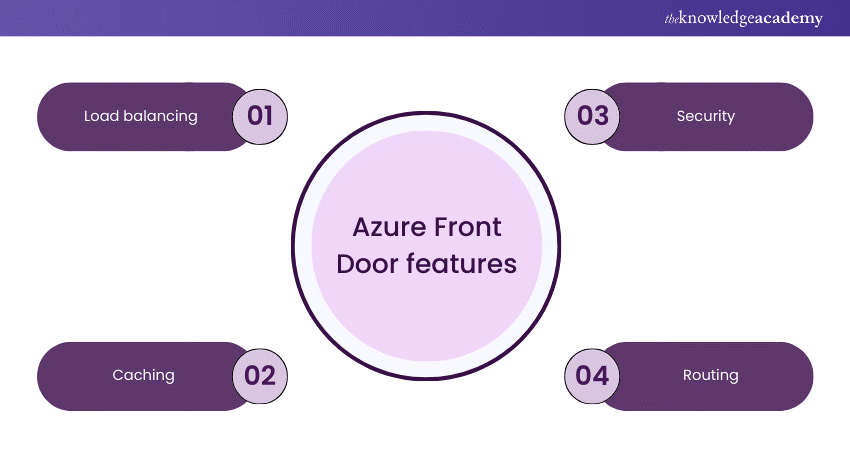We may not have the course you’re looking for. If you enquire or give us a call on +44 1344 203 999 and speak to our training experts, we may still be able to help with your training requirements.
Training Outcomes Within Your Budget!
We ensure quality, budget-alignment, and timely delivery by our expert instructors.

Suppose you are a Web Developer or an Administrator. In that case, you might have faced challenges such as slow loading times, high latency, network failures, or cyberattacks that affect your Web Applications' User Experience and security. You might also wonder how to scale your Web Applications to meet the growing demand of your users across different regions and devices. These are some of the problems that Azure Front Door can help you solve.
Azure Front Door is a global entry point for your Web Applications that run on Microsoft’s massive global network. It acts as a reverse proxy that receives requests from your users and routes them to the best available backend based on proximity, health, and load. This blog will explore the details of Azure Front Door and see how it can benefit your Web Applications.
Table of Contents
1) What is an Microsoft Azure Front Door?
2) Why use Azure Front Door?
3) How does Azure Front Door works?
4) Azure Front Door features
5) Core capabilities of Azure Front Door
6) Conclusion
What is Microsoft Azure Front Door?
Azure Front Door is a service-oriented Application Delivery Network (ADN) that provides a suite of Layer 7 load-balancing solutions for applications. It’s a highly available, scalable, and Azure-managed service.
This service enhances the performance of Web Applications worldwide through Dynamic Site Acceleration (DSA) and global Load Balancing, featuring near-instantaneous failover. The proximity of end-users is a critical factor for global enterprises, as it significantly affects application performance.
To ensure a uniform and improved user experience, enterprises can deploy Content Delivery Networks (CDNs), which utilise multiple distribution points to swiftly deliver content, thanks to optimised connections and geographical closeness to consumers.
Azure Front Door employs the anycast protocol, surpassing traditional CDN functions by incorporating advanced security features like DDoS attack prevention.
The service operates on a globally distributed, multi-tenant infrastructure that is shared among all customers. By creating a Front Door profile, organisations can tailor configurations to their application’s specific needs. Modifications to a Front Door setup are isolated and do not affect other configurations.
Why use Azure Front Door?
Azure Front Door can provide you with the needed improved performance, availability, and security of your Web Applications by the following:
a) Performance: Azure Front Door can make your Web Application request delivered faster to the endpoint by shortening the latency and increasing the throughput. It can also cache the static content at the edge and compress the content sent to the user. Azure Front Door was designed with HTTP/2 and IPv6 protocols, which can make your Web Applications even faster.
b) Availability: Azure Front Door will help you protect the availability and reliability of your Web Applications by checking up on the health and load of your backend servers It can also automatically failover to the best next backend if a failure occurs and distribute the traffic evenly between the available backends. Azure Front Door, in addition to session affinity, can persist the state of the Web Application across multiple requests.
c) Security: Azure Front Door defends your web applications against cyberattacks by encrypting traffic between users and frontend hosts, and between backend servers and frontend hosts, using SSL/TLS certificates.
Azure Front Door also shields DDoS attacks, that often are called Distributed Denial-of-Service attacks, that are aimed at flooding and crashing your services. Similarly, the service provides a Web Application Firewall (WAF) that can block malicious requests which are injected using SQL injection, cross-site scripting, and remote file inclusion among others.
Register to build a solid foundation in cloud concepts with Microsoft Azure Fundamentals AZ-900 Certification now!
How does Azure Front Door work?
The following steps can explain the working of Azure Front Door:
a) The user sends a request to the frontend host of Azure Front Door using the Web Application.
b) The frontend host receives the request and evaluates the routing rules to determine which backend pool to route it to. For example, if the request is for the URL path /blog, the frontend host may route it to the backend pool that hosts the blog Web Application.
c) The frontend host checks the cache to see if the requested content is cached. If the content is cached and fresh, the frontend host returns it to the user. The frontend host proceeds to the next step if the content is not cached or stale.
d) The frontend host sends a health probe to the backend pool to check the availability and response time of the backend servers. The health probe is a simple HTTP/HTTPS request that expects a 200 OK response from the backend server. The user can configure the health probe frequency and timeout.
e) The frontend host selects the best available backend server from the backend pool based on proximity, health, and load. The frontend host also applies security policies such as SSL/TLS encryption, DDoS protection, and Web Application Firewall (WAF) to the request.
f) The frontend host forwards the request to the selected backend server using the original URL or a modified URL based on the routing rules. For example, if the request is for the URL path /blog, the frontend host may forward the request to the backend server.
g) The backend server processes the request and returns the response to the frontend host. The response may contain static or dynamic content, such as HTML, CSS, JavaScript, images, or videos.
h) The frontend host receives the response and caches it if enabled, and the response meets the caching criteria. If the compression is enabled and the response is compressible, the frontend host compresses the response.
i) The frontend host returns the response to the user using the same protocol and URL as the request. The user receives the response and renders the content on their device.
To become proficient at using Microsoft Azure, sign up for our Microsoft Azure Big Data Analytics Solutions M552241 Course now!
Azure Front Door features
Azure Front Door offers a range of features that can help you optimise your Web Applications' performance, availability, and security. Some of the key features are:

Load balancing
Azure Front Door can balance the load among multiple backend servers using round-robin, weighted round-robin, active-passive, or performance-based algorithms. You can also configure custom load-balancing settings for each backend server, such as session affinity, priority, or weight.
Caching
Azure Front Door can cache the static content of your Web Applications at the edge, using the frontend hosts as cache nodes. For each routing rule, you can configure cache settings such as cache duration, behaviour, key, or bypass. You can also purge the cache manually or programmatically when needed.
Security
Azure Front Door can secure the traffic between the user and the frontend host and between the frontend host and the backend server, employing the SSL/TLS certificates. You can use either your own custom domain and certificate or the default domain and certificate which are provided by Azure Front Door. Azure Front Door also offers DDoS protection that can detect and mitigate distributed denial-of-service attacks on your Web Applications.
Further, Azure Front Door has a Web Application Firewall (WAF) that filters out malicious requests like SQL injection, cross-site scripting or remote file inclusion that are most common web vulnerabilities. You have an option to build your own WAF policies and rules or may use the predefined ones provided by Azure Front Door.
Routing
Azure Front Door can route the requests from the frontend hosts to the backend pools using your defined routing rules. You can create routing rules based on criteria such as URL path, HTTP method, header, query string, or cookie. You can also configure routing rules to enable caching, compression, redirection, rewriting, or custom forwarding. Each routing rule has a priority that determines the order of evaluation.
Enhance your skills in Azure big data analytics and get certified with Microsoft Azure Big Data Analytics Solutions M552241 Training. Get started now!
Core capabilities of Azure Front Door
Let’s look at some of the core capabilities of Azure Front Door:
a) Application and API acceleration: The Azure front door is set up so that Anycast is used to optimally connect to Azure application services. It ensures this by minimising the delay for each end user, which means their applications and APIs can be accessed quickly.
b) SSL offload: Simpler and cheaper SSL decryption is offloaded upstream at Azure's Front Door, avoiding expensive computations at the endpoints. This improves performance and promotes real-time services and responsiveness at the front end.
c) Global HTTP Load Balancing: It is easy to put the geo-distributed services leveraging the Front Door of Azure. Smartly traversing paths will route traffic to local areas and endpoints as dictated by the endpoints’ availability status. This way, regions are utilising each region well, therefore working efficiently across different areas.
d) Web Application Firewall (WAF): Azure is trying to build FrontDoor with web application filtering at the border. Shields the servers from DDoS and malicious users while providing uninterrupted continuity with backend services. Doing so ensures your app's security goes smoothly.
Do you want to gain a competitive edge in the market? Then register now for our Microsoft Azure Training!
Conclusion
Azure Front Door is a powerful and versatile service that can help you deliver fast, reliable, and secure Web Applications worldwide. It offers Load Balancing, caching, security, and routing features to optimise your Web Application's performance and availability. It also supports any protocol, backend, domain, and region.
Sign up for our Designing and Implementing Microsoft DevOps Solutions AZ400 Course to gain insights on implementing the DevOps development process!
Frequently Asked Questions

You can monitor and troubleshoot Azure Front Door using the following tools and methods:
1) Azure portal
2) Azure monitor
3) Azure CLI
4) Azure resource explorer
5) Network watcher

You can monitor and troubleshoot Azure Front Door using the following tools and methods:
1) Azure portal
2) Azure monitor
3) Azure CLI
4) Azure resource explorer
5) Network watcher

The Knowledge Academy takes global learning to new heights, offering over 30,000 online courses across 490+ locations in 220 countries. This expansive reach ensures accessibility and convenience for learners worldwide.
Alongside our diverse Online Course Catalogue, encompassing 17 major categories, we go the extra mile by providing a plethora of free educational Online Resources like News updates, Blogs, videos, webinars, and interview questions. Tailoring learning experiences further, professionals can maximise value with customisable Course Bundles of TKA.

The Knowledge Academy’s Knowledge Pass, a prepaid voucher, adds another layer of flexibility, allowing course bookings over a 12-month period. Join us on a journey where education knows no bounds.

The Knowledge Academy offers various Microsoft Azure Training, including Microsoft Azure Fundamentals AZ900, Microsoft Azure AI Fundamentals AI900 and Microsoft Azure Security Technologies AZ500 Courses. These courses cater to different skill levels, providing comprehensive insights into Azure Quantum.
Our Microsoft Technical Blogs cover a range of topics related to Microsoft Azure. offering valuable resources, best practices, and industry insights. Whether you are a beginner or looking to advance your Microsoft Technical skills, The Knowledge Academy's diverse courses and informative blogs have you covered.
Upcoming Microsoft Technical Resources Batches & Dates
Date
 Microsoft Azure Fundamentals AZ-900 Certification
Microsoft Azure Fundamentals AZ-900 Certification
Fri 3rd Jan 2025
Fri 2nd May 2025
Fri 4th Jul 2025
Fri 5th Sep 2025
Fri 7th Nov 2025







 Top Rated Course
Top Rated Course



 If you wish to make any changes to your course, please
If you wish to make any changes to your course, please


